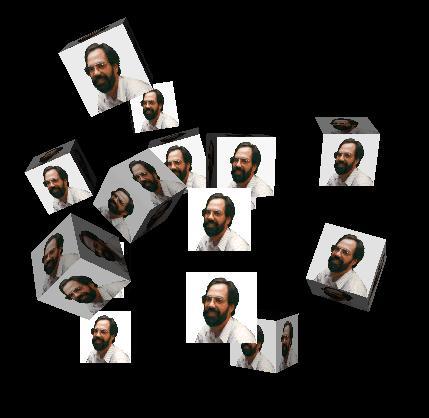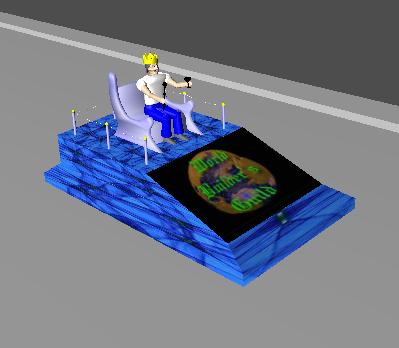Are you still working on VRML worlds or do you exclusively work on X3D worlds now ?
I still work mostly with VRML, though I do experiment with X3D. This is because more people understand VRML and have a viewer for it, and because I do not know of any X3D multi-user websites.
Do you think that VRML is really dead ?
Yes. As a language, VRML will no longer grow or be developed. VRML was first designed for 3D, then a time component was added with the animations of VRML97. But when first developed, there was no thought of interaction with databases, operating systems, or other programs. XML is an interchange language, a it provides a bridge between systems. X3D can not only render the structures of classic VRML, but also has the ability to be extended to interact with these other systems.
After all those years and all those worlds you made, what keeps your world-builder passion alive ?
Sadly, the passion has diminished  I have not created a world in some time. There are many reasons for this, life changes such as getting a new job and getting older, or playing more music instead of sitting at the computer and also changes in Windows that cause programs to run less reliably (frequent crashes). I realize that programmers are trying to improve software and operating systems when they release new versions, but sometimes that just makes things more unstable. The last time I tried to scale a simple cylinder, Flux Studio crashed… I had not even begun to get started on my great creation. It made me sad, and tired.
I have not created a world in some time. There are many reasons for this, life changes such as getting a new job and getting older, or playing more music instead of sitting at the computer and also changes in Windows that cause programs to run less reliably (frequent crashes). I realize that programmers are trying to improve software and operating systems when they release new versions, but sometimes that just makes things more unstable. The last time I tried to scale a simple cylinder, Flux Studio crashed… I had not even begun to get started on my great creation. It made me sad, and tired.
Do you still work only for cybertown or do you do some things just for you ?
 I’ve always done things “just for me”. Sometimes I shared them with cybertown, but most often I put them out on the web in general. I uploaded many early objects to the Cybertown Mall, and then later did a lot of work with the suburbs ; mostly gathering submitted worlds and uploading them and altering web pages to add them to the index.
I’ve always done things “just for me”. Sometimes I shared them with cybertown, but most often I put them out on the web in general. I uploaded many early objects to the Cybertown Mall, and then later did a lot of work with the suburbs ; mostly gathering submitted worlds and uploading them and altering web pages to add them to the index.
And what do you do exactly for cybertown now ?
I still try to attend the weekly World Builder’s Guild meetings to talk about VRML topics and other things. I am not near as active as I used to be four of five years ago. This is due to less personal time for the activity, and due to numerous little changes over time that have happened. Many of my old friends did not transition when the site “went pay”, the Mall rules got more and more complicated, and the 3D crashes so often as to be frustrating. It is still a unique community, I developed many friendships, and I have fond remembrances of times spent there.
How do you see the future of VRML Communities ?
I think there is a place for it, but it will be more complicated and more commercial. A 3D shopping mall is inevitable.
With some blockbusters like Second Life, how can a VRML Community live or survive ?
VRML/X3D will survive because it is Open Source ; it is owned by the community and not a particular company. Companies come and go and trade hands, their agenda may change. This happened when SGI sold it’s Cosmo division to Interrvista, and then they got bought out. If SGI “owned” VRML, the format would have died back then. So VRML is not dead so much as it has evolved to a new more robust and useful format. It is still an International Standard and is still owned by the community.
According to your huge experience in Vrml, how do you think we can promote it ?
Develop compelling worlds that have a reason to exist and can not be ignored.
A technical question now, from all the modelers you have tried, which is your favorite one and why ?
I have always suggested trying many different modeling tools, it helps to get you to understand how different programmers approach building 3D models on a 2D screen. That said, it is no secret that I have long used Spazz3D, which became VizX3D, and then Flux Studio. It was free for a long time and the current release of Flux is still free (the price was right for my budget). I have many more tools. I particularly liked Home Space Designer for the Russian group that evolved into ParallelGraphics. It was good for buildings and handled textures particularly well. It’s animation capabilities were limited, so I often built structures with HSD, then added animations and other features with Spazz3D. I liked to used Leveller for terrains.
With all the worlds you made, whitch is your favorite and why ?
Hard question. I would say that for personal reasons, the 1st VRML Church is one of my favorites. The exterior was designed after an old Louisiana church that was on a painting in my psychiatrist’s office, I often stared at it while I was waiting for my appointment. The interior was designed after the church my in-laws attended. I have now moved into their home and attend that church myself. It was the first 3D church that I am aware of, and I have attended weddings and funerals there. It was more than a 3D structure, it had a purpose.
How do you consider VRML/X3D ? Like an Art or just a technology, just as a game ?
All of the above ? I always approached it as an art more than a science, but I am more of an artist than a programmer. For me, it must be a game or a hobby, like fishing, it is something I do for the challenge and enjoyment. I have used it to convey scientific ideas, and I see 3D used on TV daily for visualizations, but I have never thought I would earn a living from my 3D skills.
What did you motivate to start learning VRML and what motivate you now ?
I was learning mark-up languages, and VRML was another one. I liked 3D visualization and was amazed that I could actually create something on my own. I recall being very pleased when my first simple structure took place from a series of columns and boxes that I was able to stack and arrange. Later motivations came from sharing my knowledge with others and working to build a civilization. Recently, my enthusiasm has dropped, or I find other things to occupy my time.  I still have a world that I would like to build, I have started on it a few times, one day I may finish.
I still have a world that I would like to build, I have started on it a few times, one day I may finish.
This is just our 2nd exhibition, but what do you think about our project ?
I think it is interesting, and I am glad to be able to participate. Forums like these may help to keep VRML/X3D alive on the web.
What could you say to someone who would like to start a VRML/X3D world ?
Sketch out a plan or design before you begin modeling. Try many different modeling tools until you find one you understand and like. Try to find an idea that has not been done, but needs to exist. Take small steps. Save often.
Which of the possible X3D encodings do you use when you build by hand (classical, xml, …) ?
Classical VRML97. This is because the version of VRMLpad I have does not support X3D. I am learning more of the XML syntax at work, so my exposure to X3D was good back-ground and it is getting easier for me to read.
Do you know or guess why the w3d consortium was moved to call for a brand new standard and what should move VRML content creators to change over to X3D ? (That’s may be two questions for one single answer).
I think I addressed this earlier. X3D is 3D with an XML syntax. VRML stood alone, a unique mark-up language, but XML is a way for communication with many things ; different operating system (XP uses XML to created lists of files in folders, etc…), different databases, web pages, other programs, etc… There are many more people who know XML than those that know VRML, X3D is easier for them to understand and to write programs to interact with. X3D is a part of a much larger language base and is more powerful than what was envisioned at the time VRML was created. Lastly, X3D is extensible, it was designed from the start to be added to and modified in ways that the original developers had not imagined. One recent addition has been the network adaptor that allows network interactions in a multi-user situation.
Background : In HTML the are predefined tags, the page author puts content into these “buckets”. For example *H1* for header, or *P* for paragraph. With XML, the author defines both the contents and the “buckets”, it is easy to add new terms that the original designers did not think of. You can make a new tag such as *PRICE* or a new tag such as *BOX* ; it is much more flexible. X3D has the same 3D concepts as VRML, but it is implemented in XML constructs. VRML had predefined set of tags (like HTML), X3D has predefined tags, but is also extensible.




























